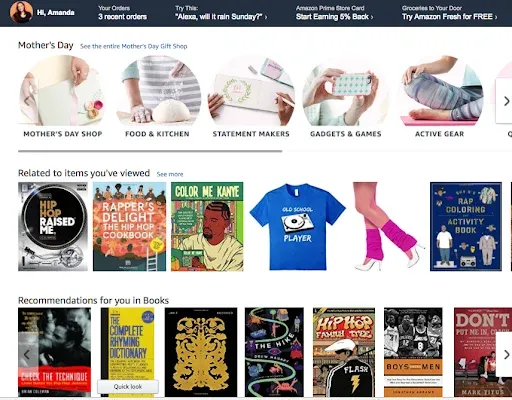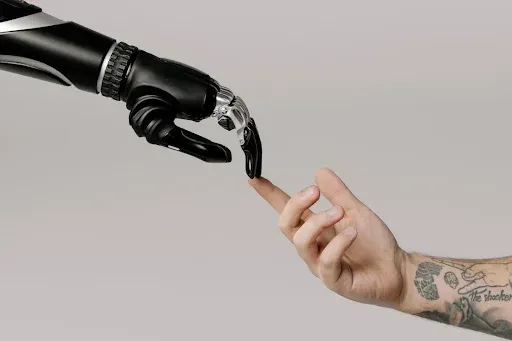Table of Contents
Artificial intelligence, or AI, has transformed how businesses operate and find growth opportunities.
A 2023 survey revealed that global marketing professionals use AI to align content creation and marketing with search intent, enhance website user experience, and boost search engine rankings.
While these are the top three objectives, all efforts aim to reach one goal: to gain customers and strengthen their loyalty. But how do you leverage AI efficiently to maximize customer engagement and retention in this contemporary marketing landscape?
Best AI practices for loyalty marketing
While marketing strategies are unique to each business, AI provides optimization tactics that apply to all. As such, here are the best practices to enhance customer loyalty in 2024:
1. Integrate chatbots into your sales channels
Customer experience refers to customers’ impressions of your brand throughout their buying journeys. Factors like ease of resolution and navigation between sales channels influence these impressions.
AI helps enrich your customer experience by streamlining every touchpoint, particularly customer service and support, to address concerns immediately and provide seamless movement within websites and social media profiles. Among the notable customer support integrations are chatbots.
Chatbots are computer programs that use conversational AI to automate messages and responses. These integrations make it easy for customers to find and understand information without manual research or human interventions.
At the same time, chatbots provide 24/7 assistance that serves customers even when agents are offline. You can automate them with responses based on frequently asked questions, allowing customers to reach and learn more about your business at their most convenient time.
However, responses based on FAQs are traditional chatbot features, requiring users to select prompts to move the conversation forward.
Over time, chatbots have become capable of complex programming and natural language understanding (NLU), allowing users to initiate conversations without choosing prompts. These algorithms innovated contextually aware chatbots that can understand human language.
Suppose you’re a travel agency owner with a website that has a chatbot. When a visitor sends a message asking for travel recommendations, the chatbot asks for the specifics of their preferences. Then, the algorithms will analyze the answer to provide suggestions that align with the user’s interests and needs.
The following are examples of chatbot integrations on brands’ sales channels:
Health and wellness brand Mindvalley’s chatbot lets users choose between learning from them or contacting their customer support:

As chatbots continuously evolve, developers scale AI applications such as machine and deep learning to develop algorithms that enhance chatbots’ understanding and processing capabilities. Leveraging these technologies can provide versatile customer support that strengthens retention and loyalty.
2. Create personalized recommendations
AI can strengthen personalization in your marketing campaigns.
Machine learning and natural language processing (NLP) integrations comprehensively analyze consumer needs, interests, preferences, and behaviors, helping you develop strategies that resonate with prospects and customers. This benefit is essential in building strong and genuine customer relationships.
For these reasons, AI customer analysis can create personalized recommendations and experiences based on interactions, transaction histories, and customer behaviors.
For example, users shopping around your website may receive product suggestions matching their preferences and past purchases. Similarly, users who consistently interact and engage with home ownership-related content that might need lower interest rates or better mortgage terms could receive financing recommendations like a home refinance offer in their mobile banking apps.
Here’s an example of personalized recommendations on Amazon. The user received suggestions based on their previously viewed listings.

Moreover, AI lets you create personalized loyalty programs for each customer. Customers who frequently buy shoes will receive discount offers for their next shoe purchase, while others who show interest in other products will receive promos based on their preferences.
Spotify's annual Wrapped is a famous example of a personalized loyalty program that uses AI. This feature analyzes users’ listening habits within a specific time frame and curates a summary based on this information. It shows top artists, genres, songs, and messages from singers:

This intelligent personalization is something to incorporate into your 2024 marketing strategies, as it helps provide a more enticing and rewarding customer experience.

3. Implement predictive analytics
Predictive analytics is an AI application that uses machine learning and statistical algorithms to forecast results based on historical data. In marketing, this technology involves using customer data to predict their future interests, preferences, and behaviors.
Implementing predictive analytics in your customer acquisition strategies can yield the following benefits:
- It helps you analyze big data on consumer demographics by categorizing potential customers based on your requirements in just a few clicks. You can then scale this information down to create hyper-targeted advertising campaigns
- Identifies untapped market segments that offer growth opportunities, letting you expand your customer base and reach
- It performs a historical review of all your service outages and incidents over the last 12 to 24 months. This holistic analysis can reveal potential and common issues around specific solutions, helping you address and modify them to prevent inconveniences
- Enhances sentiment analysis by determining whether customer feedback has positive, negative, or neutral undertones, letting you address potential issues to improve customer satisfaction and create more customer-centric marketing campaigns
- Calculates the customer lifetime value, or CLV, to determine high-value customers. This analysis helps you redirect and nurture your efforts and resources to loyal customers to increase retention and profitability
- It helps you create an ideal customer buying journey by analyzing how potential customers might perceive and use your products or services through historical data from previous customers.
- Churn combines the word change and turn, which means customers leave a service or migrate to competitors within the same industry. Churn predictions are highly significant in retaining customers and attracting new ones.
Case study of companies leveraging AI to improve customer loyalty
One case study about predictive analytics focused on “churn” predictions in a large Brazilian bank.
The study found that low churn rates showed that customers with robust relationships with the institution, who borrow more, and who have more products and services are less likely to close their checking accounts.
Conversely, high churn rates revealed that many customers are leaving the service.
This prediction uses four sets of data: customer behavior, macro-environment variables, customer perceptions, and customer demographics.
It also emphasizes the importance of investing in cross-selling and upselling strategies for customer retention.
1. Add gamification elements
Another strategy to incorporate in your 2024 marketing strategies is gamification AI.
Gamification AI uses intelligent technologies to make gamification elements more personalized, engaging, and adaptive. This fusion enables you to create responsive experiences tailored to customer preferences and interests.
With gamification AI, you can integrate elements like challenges, badges, levels, and games with incentives to motivate customers to play and earn rewards from your loyalty programs.
For example, a fitness brand uses AI to analyze customer data—like preferred activities, workout routines, and fitness goals—for loyalty programs.
They use this information to create personalized challenges, encouraging customers to engage in activities aligned with their interests. These programs could be completing a specific number of workouts within a time frame or earning rewards for achieving a fitness milestone.
This gamified approach helps enhance customer engagement by making interactions more interactive. At the same time, recognizing and rewarding customer efforts can foster emotional connection, deepening the sense of loyalty.
One example of AI gamification is Funko’s “POP! Yourself!” This feature allows users to make their own Funko pops, which they can buy or save as an avatar.

Furthermore, you can update your AI-powered, gamified loyalty programs to ensure they remain relevant to customers. Not only does this keep the programs interesting, but it also helps reinforce fresh recognition tactics that nurture customers’ emotional connection with your brand.
An example of a gamified loyalty program with reward mechanisms is McDonald’s buy five get one free McCafe. The loyalty program instills a sense of exclusivity, as only those participating can enjoy the benefits. By gamifying the promo, McDonald's creates a compelling and rewarding customer experience, ultimately driving brand loyalty and repeat business.

As such, gamification AI is a cutting-edge tool, strategically blending psychology, technology, and marketing to drive higher customer engagement and retention rates.
2. Innovate and scale your products or services
AI can be a compelling tool for product or service innovation, a benefit some marketers overlook. Besides understanding consumer preferences and predicting future behaviors, you should use this technology to innovate and scale your products or services.
AI’s critical advantage in product or service innovations lies in its ability to provide in-depth longitudinal benchmarking that doesn’t rely on generic surveys. This benchmarking is a distinct method that monitors changes and trends in products and services over time.
Such an intelligent technology offers the following innovative strategies:
- Long-term data analysis: Uses historical data to analyze how trends and changes will affect your products and services
- Competitor analysis: Unlike traditional competitor analysis that monitors opportunities and gaps, AI offers a scalable evaluation that predicts how your products or services stack up against competitors once they’re launched and used by customers
Moreover, AI lets you leverage the “flywheel effect,” a strategy that relies on consistency to increase momentum and ensure continuous improvement. The more you use AI, the more data it learns, helping it perform better than before.
Thus, innovating and scaling your products or services with AI can ensure their long-term market competence.
Embrace AI to build a loyal customer base
AI promises streamlined operations that create more personalized, targeted, interactive, and rewarding customer experiences. Embracing this technology lets you leverage its capability to help you foster a loyal customer base that can become brand advocates in the long run.


